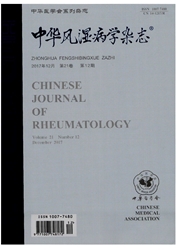

 中文摘要:
中文摘要:
目的进一步精细定位Oia2区域,以期发现除C型凝集素超家族成员(CLECSFs)以外的其他关节炎易感基因。方法在DA大鼠及其同源异基因品系R16大鼠中建立矿物油诱导性关节炎(OIA)模型并记录各临床表型。另取DA和R16大鼠,不完全弗氏佐剂(IFA)免疫后第10天,处死并采集腹股沟淋巴结以获取单个细胞,在mRNA水平检测各R16同源异基因及各炎性细胞因子的表达。两两比较采用Mann—WhitnevU检验。结果OIA模型中,和雄性DA大鼠比较,雄性R16大鼠的关节炎严重程度明显减轻(5.9±3.8与9.3±2.3,P〈0.05),同时其促炎性细胞因子白细胞介素(IL)-17(1.4±2.2与2.7±2.9,P〈0.05)和IL—1β(1.5±2.1与2.3±2.5,P〈O.05)的表达水平明显下降;雄性R16大鼠钙结合蛋白-3(Clstn3)基因的表达明显减低(0.7±0.4与2.2±1.6,P〈0.01)。结论Clstn3基因与雄性大鼠关节炎严重程度密切相关,Clstn3可能为雄性大鼠所特有的关节炎易感基因,同时也表明Clstn3基因变异对雄性大鼠OIA严重程度的影响可能通过辅助T细胞(Th)17型免疫反应而发挥作用。
 英文摘要:
英文摘要:
Objective To identify the susceptibile genes in a rat model for rheumatoid arthritis (RA), to determine whether sex affects disease onset and to define the mechanisms that impacts congenic genes on arthritis. Methods Arthritis-susceptible DA rats were compared with sex/age-matched congenic rats in which alleles were substituted with alleles from arthritis resistant PVG rats. Incomplete Freund's adjuvant (IFA) was injected from the base of the tail. Arthritis was visually scored, the messenger RNA (mRNA) levels of congenie genes and cytokine were determined by reverse transcription-polymerase chain reaction. The differences between two groups were analyzed using Mann-Whitney U test. Results In oil-induced arthritis (OIA), male congenic R16 rats deviated profoundly from DA rats by decreased arthritis severity (5.9±3.8 vs 9.3±2.3, P〈0.05), and markedly reduced lymph node mRNA levels for calsyntenin-3 (Clstn3) gene (0.7±0.4 vs 2.2±1.6, P〈0.01 ) and interleukin (IL)- 17 ( 1.4±2.2 vs 2.7±2.9, P〈0.05) and IL- 1β ( 1.5±2.1 vs 2.3±2.5, P〈0.05) levels. Conclusion Rat Clstn3 gene regulates the production of pro-inflammatory cytokines of OIA in male rats. The effect of arthritis-susceptible gene Clstn3 is gender-specific.
 同期刊论文项目
同期刊论文项目
 同项目期刊论文
同项目期刊论文
 期刊信息
期刊信息
